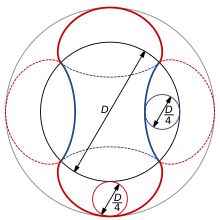Cycloid gear
This article includes a list of references, related reading or external links, but its sources remain unclear because it lacks inline citations. (April 2009) |
The cycloidal gear[example needed] profile is a form of toothed gear used in mechanical clocks[why?][citation needed], rather than the involute gear form used for most other gears. The gear tooth profile is based on the epicycloid and hypocycloid curves, which are the curves generated by a circle rolling around the outside and inside of another circle, respectively.
When two toothed gears mesh, an imaginary circle, the pitch circle, can be drawn around the centre of either gear through the point where their teeth make contact. The curves of the teeth outside the pitch circle are known as the addenda, and the curves of the tooth spaces inside the pitch circle are known as the dedenda. An addendum of one gear rests inside a dedendum of the other gear.
In the cycloidal gears, the addenda of the wheel teeth are convex epi-cycloidal and the dedenda of the pinion are concave hypocycloidal curves generated by the same generating circle. This ensures that the motion of one gear is transferred to the other at locally constant angular velocity.
The size of the generating circle may be freely chosen, mostly independent of the number of teeth.

A Roots blower is one extreme, a form of cycloid gear where the ratio of the pitch diameter to the generating circle diameter equals twice the number of lobes. In a two-lobed blower, the generating circle is one-fourth the diameter of the pitch circles, and the teeth form complete epi- and hypo-cycloidal arcs.
In clockmaking, the generating circle diameter is commonly chosen to be one-half the pitch diameter of one of the gears. This results in a dedendum which is a simple straight radial line, and therefore easy to shape and polish with hand tools. The addenda are not complete epicycloids, but portions of two different ones which intersect at a point, resulting in a "gothic arch" tooth profile.
A limitation of this gear is that it works for a constant distance between centers of two gears. This condition -in most of the cases- is impractical because of involvement of vibration, and thus in most of the cases, an involute profile of the gear is used.
There is some dispute over the invention of cycloidal gears. Those involved include Gérard Desargues, Philippe de La Hire, Ole Rømer, and Charles Étienne Louis Camus.
A cycloid (as used for the flank shape of a cycloidal gear) is constructed by rolling a rolling circle on a base circle. If the diameter of this rolling circle is chosen to be infinitely large, a straight line is obtained. The resulting cycloid is then called an involute and the gear is called an involute gear. In this respect involute gears are only a special case of cycloidal gears.[1]
See also[]
References[]
- ^ tec-science (2018-12-21). "Geometry of cycloidal gears". tec-science. Retrieved 2019-11-10.
- Ross, D. S. (2010). "The inverse trochoid problem". J. Franklin Institute. 347 (7): 1281-1308 (2010). https://doi.org/10.1016/j.jfranklin.2010.06.003
External links[]
- Designing cycloidal gears
- Kinematic Models for Design Digital Library (KMODDL)
Movies and photos of hundreds of working mechanical-systems models at Cornell University. Also includes an e-book library of classic texts on mechanical design and engineering. - 2 and 4-cog cycloidal gears in motion
- Gears
- Roulettes (curve)